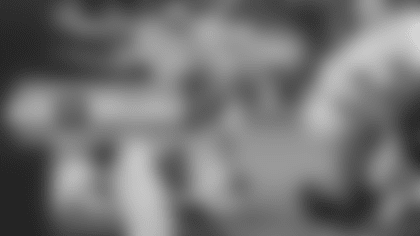**

Here's our sixth round of X's and O's with Mike Nolan. Thanks again to all of our fans who sent in questions, and keep them coming as Coach will answer questions every Friday!**
Q: Jay Moore was a very interesting draft choice in 2007, a down lineman projected as a linebacker. Several players have made that transition successfully. I'd love to see him make that level of contribution. Now that he has recovered from his injury and spent some time in mini camp, how does he look now as an OLB?- Dick Flynn, Sunriver, Oregon
A: With respect to Jay Moore, he was making the transition and was injured in the final preseason game but he was getting better all the time. He's made outstanding progress this off-season and he's much more familiar after watching the position for a year on injured reserve. He's had to do a lot of his improvement in film study and meetings, but he did very well in mini camp and we look for him to compete for a spot on our roster. He's done well with the transition to this point and we hope to see more out of him this fall.
Q: Are you concerned that opening the QB competition can fragment the locker room? Could it have just been best to name a starter and then hold a press conference if you felt it was best to go in a different direction? - Nancy, Pleasonton
A: First off, it's important that all players at all positions compete for the job. I think our players on the team respect one another better when they do compete for jobs. I think every player would expect every position to be open for competition. Competition makes us better. It either pushes someone out because they got beat out, or it makes the individual who already has the job to get better to keep his job. We do not have a team of football players who shy away for competition. One of the most impressive things at our quarterback position right now and something that is a pleasure to see is that all three players accept the competition, and enjoy the competition. That's how they become professional athletes to begin with.
Q: Coach, which NFL team are you most excited about playing this year? I bet facing the same division teams each year gets kind of boring so a new team in the mix from outside the division has to be refreshing. Thanks, Tyler from Columbus Ohio.
A: The NFL season and the teams you play changes each year with the exception of your division opponents. Playing the teams in your division twice a year is what actually creates the rivalry among divisions which is exciting in itself. There's been the suggestion that we have those games early and late in the season to make those games more meaningful. So playing familiar teams is fun because of the rivalries that build up, but it is an interesting aspect to travel around the country and play some teams that you don't play year in and year out because the match-ups between some of your best players and some of theirs is always fun to watch.
Q: Coach Nolan, I have been an avid 49er fan for years. I admired your father and the most disappointing game was his 1971 NFC championship when Dallas scored twice in the last 60 seconds to win a trip to the Super Bowl. My question, How can weight lifting injuries be prevented? David Baas this year tore a pectoral muscle that required surgery, although the most common weight lifting injury seems to be the bulging disc. Should players be scrutinized more carefully in the weight room? Orlando, NapaA: The off-season program, which requires a lot of lifting and more than what happens during the season, is meant to make our players much bigger, faster, and stronger. That's an integral part of getting better as a football team. From a weight room standpoint, you can be very cautious in the weight room and not get better as some people do, or you can challenge your athletes at the risk of possibly getting injured, but at the same time, the objective is that we make our players better. You can also go to practice and have the same mindset and just stand around and do walk-thru's and don't practice difficult. It is very important though that the structure and environment that you have in place is right, so that guys are watched over and coached correctly on how to lift weights. I believe we have an outstanding program here and it's been a reason why we've had so many fewer injuries during the season than there were prior to our arrival. I'm very pleased with what we do here because I believe it makes our players better, and that it is also a very safe environment.
Q: Thank you for taking time to answer these questions. My question to you is what version of the 3-4 are we going to run this year? I know that we have been running a 2 gap 3-4, but in Justin Smith's interview he mentioned that we were going to use him as a 1 gap DE. I know that Coach Manusky came from the Chargers who use the 1 gap 3-4. So are we switching to a 1 gap 3-4 and what are the pros and cons of 1 gap vs 2 gap? Thank you! - Lee Caudle, Idaho Falls, ID
A: We've used a very multiple scheme since we got here, both 1 and 2-gap. We have not been a 2-gap straight across the board. In fact, we have at most in any given season used only about 20% of our entire defense in a 2-gap concept in a 3-4 so we've been much more of a 1-gap. The most important thing to know about a defense is that you base it on what your players do best. When you have big, strong guys who aren't very mobile than a 2-gap scheme usually helps that player. When you have more mobile guys who can run and slip blocks, typically it's good that you use a 1-gap system to allow those players to get off blocks and go to the ball carrier. Both schemes have been very successful. The Cowboys for the longest time under Bill Parcells used a 2-gap and were extremely good on defense, but at the same time Wade Phillips and the 1-gap and the Steelers and the Patriots with a very multiple 1 and 2-gap schemes of the 3-4 have all been very good. The answer to your question is that players determine what you play and we will continue to mix up our 1 and 2-gap schemes because in our case we do have a good complement of different types of players and when they are on the field we want to make sure we put them in positions to be successful.
Q: Thank you for being 'open and accessible' which, I think, puts you in a class all by yourself. My question is this: you wear a head set in game time, and you're in charge, while at the same time a number of others upstairs and down have head sets - how in the world do you sift through all that input, the back-and-forth, and manage to keep your focus? And is there some sort or type of listening priority system in place? - Sammy Moore Jr
A: I have a switch on my hip that takes me from offense to defense to special teams. At any given time, only one person on each side is allowed to be on the headset. Everyone can listen, but only one can speak. For example, on offense it will be on for Mike Martz, on defense it will be Greg Manusky, and then it will be Al Everest on special teams and so the head coach can speak to any of those three, I just have to switch to that unit. If I do want to speak to another coach, I can switch to that unit, let's say defense and tell Johnnie Lynn to turn his headset on and then I can speak to him. The head coach is the only one who has access to all three of the units, whereas Martz would only be on with his offensive coaches and Manusky is only on with the defensive coaches and so on. That's how we work our headsets and I believe everyone in the league is the same way. It's actually very effective.
Please submit your questions via email to**xandowithnolan@niners.nfl.com**and then check back next Friday to see if your question was selected!





